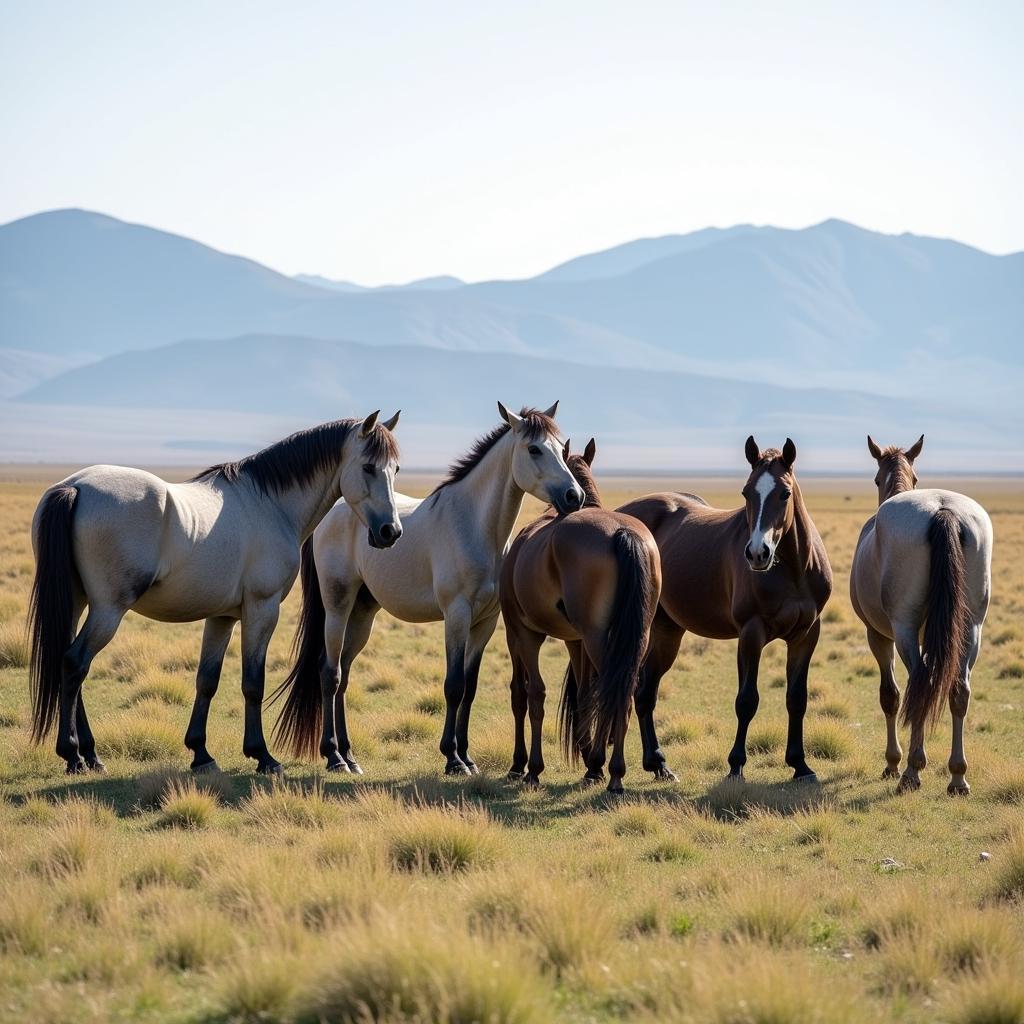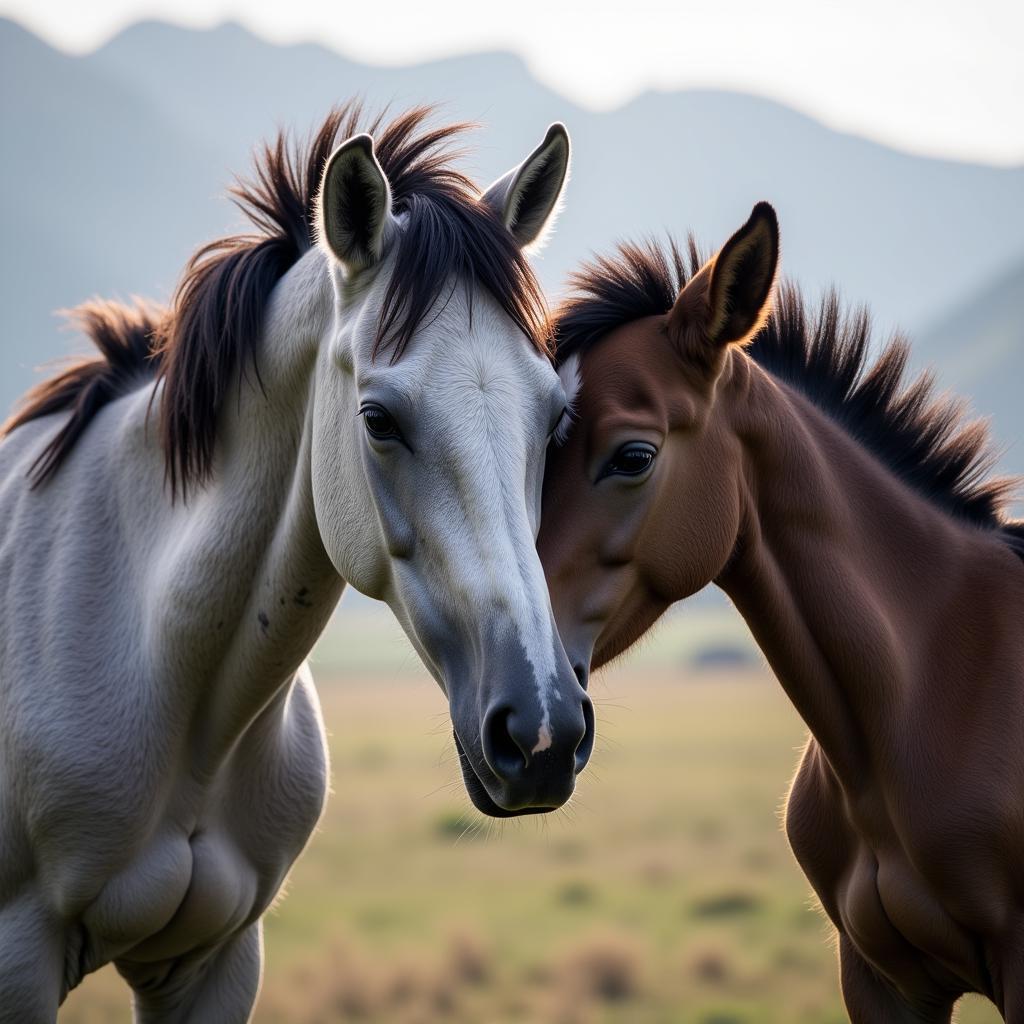The Gray Mustang Horse, a captivating symbol of the American West, embodies both power and grace. These wild horses, descendants of Spanish horses brought to the Americas centuries ago, roam freely across the vast landscapes, their silver coats shimmering under the sun. This article delves into the fascinating world of the gray mustang, exploring their history, characteristics, and the ongoing efforts to preserve their legacy. After reading this, you’ll appreciate these magnificent creatures even more.
Unveiling the Mystique of the Gray Mustang
Gray mustangs, often mistaken for white, are born with darker coats that gradually lighten with age. This progressive graying is a unique characteristic of the breed. The final coat color can range from a light, almost white shade to a dappled gray or even a “rose” gray with reddish hues. This transformation adds to their mystique, making each individual horse’s appearance unique. Many people seek information about the specific shades of gray that mustangs exhibit, which vary significantly. Do you find yourself wondering about the origins of these beautiful horses?
The history of the mustang is intertwined with the history of the American West. Brought to the Americas by Spanish explorers, these horses escaped or were released into the wild, adapting to the harsh environment and thriving for generations. This resilience has made them an enduring symbol of freedom and the untamed spirit of the West. Did you know that some mustangs even display primitive markings, such as dorsal stripes and leg barring, further connecting them to their ancient equine ancestors?
 Gray Mustang Running Free in the Western Landscape
Gray Mustang Running Free in the Western Landscape
The Physical Characteristics and Temperament of Gray Mustangs
Gray mustangs, like other mustangs, are known for their hardiness and adaptability. They are typically smaller than domesticated horses, averaging around 14-15 hands high. Their muscular build and strong legs allow them to navigate the rugged terrain of their native habitats. Their coats, while often gray, can also exhibit other colors in their younger years, before the graying process takes over. These magnificent animals have captivated horse lovers for generations.
Beyond their physical attributes, gray mustangs possess a unique temperament. They are intelligent and independent, a reflection of their wild upbringing. While they can be trained, their spirit remains untamed, adding to their allure. This independence is what draws many people to these incredible animals. What do you think contributes to their resilience?
The Breyer Horse Christmas ornament captures the spirit of these magnificent creatures, perfect for any horse enthusiast. Check it out!
Protecting the Legacy: Conservation Efforts for Gray Mustangs
The future of the gray mustang, like all mustang populations, faces ongoing challenges. Habitat loss, overgrazing, and human encroachment threaten their survival. However, dedicated organizations and individuals are working tirelessly to protect these iconic animals. These efforts include managing herd sizes, protecting their natural habitats, and promoting responsible adoption programs. Adoption programs offer a chance for these wild horses to find loving homes and experience a different kind of life. Have you ever considered adopting a mustang?
 Gray Mustang Herd Grazing on the Western Plains
Gray Mustang Herd Grazing on the Western Plains
Understanding the natural behavior of wild horses is crucial for their conservation. Mustangs live in complex social structures, with established hierarchies within the herd. This social structure plays a vital role in their survival. By understanding their natural behavior, we can better protect and manage these magnificent creatures. Are you fascinated by the social dynamics of wild horses?
What Makes a Gray Mustang Unique?
Gray mustangs possess a distinct combination of physical characteristics, temperament, and history that sets them apart. Their progressive graying, hardiness, intelligence, and wild spirit are all part of what makes them so unique. Additionally, their historical significance as symbols of the American West adds another layer to their appeal. What draws you to the gray mustang?
The wild horse in Pomeroy offers a glimpse into the untamed spirit of these animals. Explore their story!
Conclusion: The Enduring Spirit of the Gray Mustang
The gray mustang horse remains a powerful symbol of the American West, its silver coat shimmering against the backdrop of rugged landscapes. Their resilience, intelligence, and untamed spirit continue to inspire awe and admiration. By understanding and supporting conservation efforts, we can ensure that these majestic creatures continue to roam free for generations to come. The gray mustang is a true testament to the enduring power of nature. What can we do to ensure their survival?
FAQ
- Are all gray mustangs born gray? No, they are born with darker coats that gradually lighten with age.
- How big are gray mustangs? They typically average around 14-15 hands high.
- Are gray mustangs easy to train? They can be trained, but their independent nature requires experienced handlers.
- What are the main threats to gray mustang populations? Habitat loss, overgrazing, and human encroachment are major threats.
- How can I help protect gray mustangs? Supporting conservation organizations and responsible adoption programs are effective ways to help.
- What are some common misconceptions about gray mustangs? One common misconception is that they are all white. Another is that they are all completely wild and untamable.
- Where can I learn more about adopting a gray mustang? You can find information about mustang adoption programs through the Bureau of Land Management (BLM) and various mustang rescue organizations.
 Gray Mustang Mare and Foal Bonding
Gray Mustang Mare and Foal Bonding
Common Scenarios and Questions
- Scenario: You’re considering adopting a gray mustang. Question: What kind of experience and facilities do I need to provide a suitable home for a mustang?
- Scenario: You’ve spotted a gray mustang in the wild. Question: What should I do? How can I report my sighting?
- Scenario: You’re researching gray mustangs for a school project. Question: Where can I find reliable information about their history, behavior, and conservation status?
Further Exploration
For more information on horse-related topics, check out our other articles: Breyer Horse Christmas Ornament and Wild Horse Pomeroy.
Need Help?
For assistance, contact us 24/7:
- Phone: 0772127271
- Email: [email protected]
- Address: QGM2+WX2, Vị Trung, Vị Thuỷ, Hậu Giang, Việt Nam.